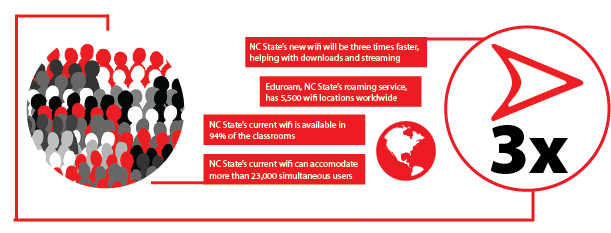
Bailey Knight
Internet access is on the verge of becoming a human necessity in most developed countries, but one of the places where it is most essential is on a college campus. Students surf the Internet to read up on topics, communicate with professors and even complete homework assignments and tests through sites like Moodle and WebAssign.
Although NC State does not currently have 100 percent wireless coverage, it is being laid out for future years. Full implementation of new protocols to replace the current settings is in the works to supply wireless access that is supposed to be three times faster and more beneficial for app downloads and streaming.
Although many students are satisfied with the coverage, speed is a common complaint, and any question about wireless connection is sure to prompt an unsatisfied response as well– usually from students less familiar with the technology.
The main problem with most networks on campus is security, according to Greg James, the associate director of data networking for Communication Technologies at NC State.
“The goal for the future of wireless is to convert as much of the campus as possible to eduroam,” James said.
“Eduroam is a secure, global wireless network accessible to anyone with an NCSU username and password. Once logged in to eduroam, students will be able to seamlessly connect to Wi-Fi in any of eduroam’s 5,500 participating locations worldwide.”
In North Carolina, these locations also include UNC-Chapel Hill, Duke, UNC-Charlotte and UNC-Greensboro. Aside from connectivity convenience, a major benefit of eduroam is a highly increased security component. However, James acknowledged that not all devices will be able to connect to eduroam and that the NCSU SSID must remain in existence for such devices.
This means in the next few years to come, students will no longer need to provide their own routers to get access to the Internet on their laptops, tablets, gaming systems and smartphones in their dorms.
NC State is home to a high-speed gigabit Ethernet with a network consisting of a fiber optic data infrastructure that can be accessed from all classrooms and residence halls. The campus network has two main means of connection: through the ResNet ports in residence halls or on the wireless networks.
Although the campus wireless network is expanding, it can currently accommodate more than 23,000 simultaneous users.
NC State’s Wi-Fi is available in 94 percent of classrooms. It is also available at major student locations on campus like NCSU Libraries, Talley Student Union, Carmichael Gymnasium, Reynolds Coliseum, Case Athletic Center and Wolf Village Apartments.
Partial coverage can be found in all of the residence halls, usually concentrated in first-floor or public lounge spaces.
“It is inconvenient to not have coverage in the individual dorm rooms; however, I understand the complications of having to transmit wireless signals throughout campus,” said Adam Davis, a freshman studying electrical engineering.
In residence halls, students have the option of either using an Ethernet cable to connect directly to the Internet through the data jack in the dorm room wall or providing a personal router to channel the ResNet to create their own sphere or wireless access within their room or suite. Within a few hours of move-in, a slew of public and private networks appear, some with more creative names than others.
Freshman T.J. Fallon, who plans to major in computer science, said he is satisfied with the coverage.
“I connected my router to the 5 ghz band, which is nearly empty in comparison to the more commonly used 2.4 ghz network,” Fallon said.
Until University-wide wireless is fully implemented, networks like “dropitlikeitshot-spot” will continue to exist.